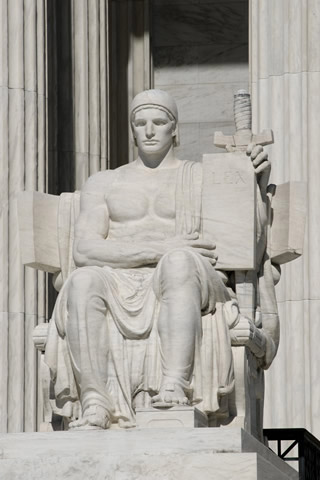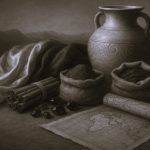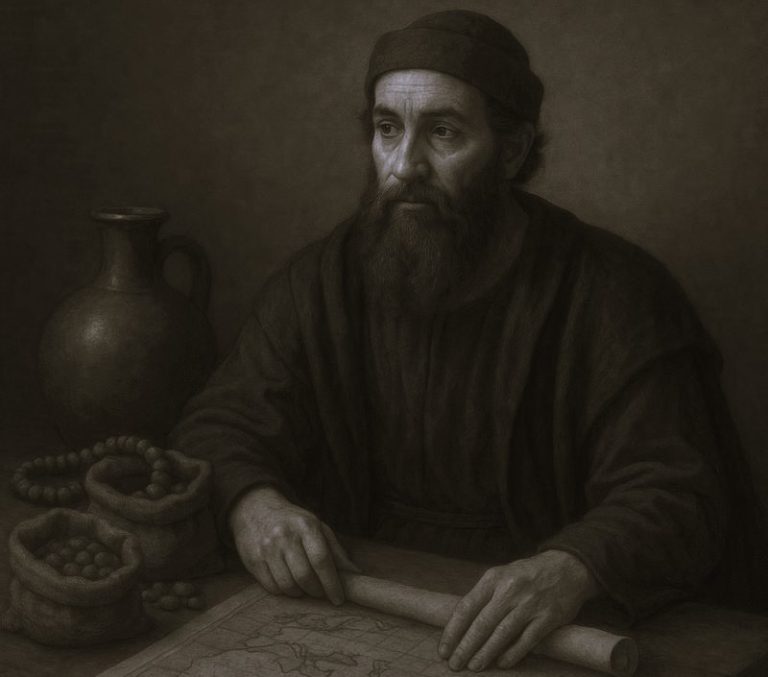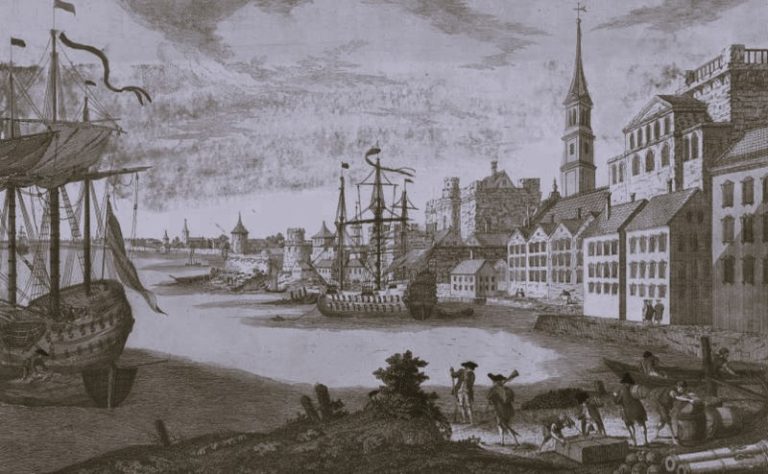


Curated/Reviewed by Matthew A. McIntosh
Public Historian
Brewminate
Building History
“The Republic endures and this is the symbol of its faith.” These words, spoken by Chief Justice Charles Evans Hughes in laying the cornerstone for the Supreme Court Building on October 13, 1932, express the importance of the Supreme Court in the American system.
Yet surprisingly, despite its role as a coequal branch of government, the Supreme Court was not provided with a building of its own until 1935, the 146th year of its existence.

Initially, the Court met in the Merchants Exchange Building in New York City. When the National Capital moved to Philadelphia in 1790, the Court moved with it, establishing Chambers first in the State House (Independence Hall) and later in the City Hall.
When the Federal Government moved, in 1800, to the permanent Capital, Washington, the District of Columbia, the Court again moved with it. Since no provision had been made for a Supreme Court Building, Congress lent the Court space in the new Capitol Building. The Court was to change its meeting place a half dozen times within the Capitol. Additionally, the Court convened for a short period in a private house after the British set fire to the Capitol during the War of 1812. Following this episode, the Court returned to the Capitol and met from 1819 to 1860 in a chamber now restored as the “Old Supreme Court Chamber.” Then from 1860 until 1935, the Court sat in what is now known as the “Old Senate Chamber.”
Finally in 1929, Chief Justice William Howard Taft, who had been President of the United States from 1909 to 1913, persuaded Congress to end this arrangement and authorize the construction of a permanent home for the Court. Architect Cass Gilbert was charged by Chief Justice Taft to design “a building of dignity and importance suitable for its use as the permanent home of the Supreme Court of the United States.”

Neither Taft nor Gilbert survived to see the Supreme Court Building completed. Construction proceeded under the direction of Chief Justice Hughes and architects Cass Gilbert, Jr., and John R. Rockart. The construction, begun in 1932, was completed in 1935, when the Court was finally able to occupy its own building.
The classical Corinthian architectural style was selected because it best harmonized with nearby congressional buildings. The building was designed on a scale in keeping with the importance and dignity of the Court and the Judiciary as a coequal, independent branch of the United States Government, and as a symbol of “the national ideal of justice in the highest sphere of activity.”
The general dimensions of the foundation are 385 feet from east to west, (front to back) and 304 feet from north to south. At its greatest height, the building rises four stories above the terrace or ground floor. Marble was chosen as the principal material to be used and $3 million worth was gathered from foreign and domestic quarries. Vermont marble was used for the exterior, while the four inner courtyards are of crystalline flaked, white Georgia marble. Above the basement level, the walls and floors of all corridors and entrance halls are either wholly or partially of creamy Alabama marble. The wood in offices throughout the building, such as doors, trim, paneled walls, and some floors, is American quartered white oak.
The Court Building cost less than the $9,740,000 Congress authorized for its construction. Not only was the final and complete cost of the building within the appropriation, but all furnishings were also procured, even though planners had initially expected that the project would require additional appropriations. Upon completion of the project, $94,000 was returned to the Treasury.
Building Features

The main entrance to the Supreme Court Building is on the west side, facing the United States Capitol. A few low steps lead up to the 252-foot-wide oval plaza in front of the building. Flanking these steps is a pair of marble candelabra with carved panels on their square bases depicting: Justice, holding sword and scales, and The Three Fates, weaving the thread of life. On either side of the plaza are fountains, flagpoles, and benches.
The bronze flagpole bases are crested with symbolic designs of the scales and sword, the book, the mask and torch, the pen and mace, and the four elements: air, earth, fire, and water.
On either side of the main steps are seated marble figures. These large statues are the work of sculptor James Earle Fraser. On the left is a female figure, the Contemplation of Justice. On the right is a male figure, the Guardian or Authority of Law.
Sixteen marble columns at the main west entrance support the pediment. On the architrave above is incised “Equal Justice Under Law.” Capping the entrance is a sculptured group by Robert Aitken, representing Liberty Enthroned guarded by Order and Authority. On either side are groups of three figures depicting Council and Research which Aitken modeled after several prominent individuals concerned with the law or the creation of the Supreme Court Building. At the left are Chief Justice Taft as a youth, Secretary of State Elihu Root, and the architect Cass Gilbert. Seated on the right are Chief Justice Hughes, the sculptor Aitken, and Chief Justice Marshall as a young man.
Too often, visitors do not see the corresponding pediment and columns on the east side. Here the sculpture group is by Hermon A. MacNeil, and the marble figures represent great lawgivers, Moses, Confucius, and Solon, flanked by symbolic groups representing Means of Enforcing the Law, Tempering Justice with Mercy, Settlement of Disputes Between States, and Maritime and other functions of the Supreme Court. The architrave bears the legend: “Justice the Guardian of Liberty.”
The monumental bronze doors at the top of the front steps weighs six and one-half tons each and slide into a wall recess when opened. The door panels, sculpted by John Donnelly, Jr., depict historic scenes in the development of law: the trial scene from the shield of Achilles, as described in the Iliad; a Roman praetor publishing an edict; Julian and a pupil; Justinian publishing the Corpus Juris; King John sealing the Magna Carta; the Chancellor publishing the first Statute of Westminster; Lord Coke barring King James from sitting as a Judge; and Chief Justice Marshall and Justice Story.

The main corridor is known as the Great Hall. At each side, double rows of monolithic marble columns rise to a coffered ceiling. Busts of all former Chief Justices are set alternately in niches and on marble pedestals along the side walls. The frieze is decorated with medallion profiles of lawgivers and heraldic devices.
At the east end of the Great Hall, oak doors open into the Court Chamber. This dignified room measures 82 by 91 feet and has a 44–foot ceiling. Its 24 columns are Old Convent Quarry Siena marble from Liguria, Italy; its walls and friezes are of Ivory Vein marble from Alicante, Spain; and its floor borders are Italian and Algerian marble.
The raised Bench behind which the Justices sit during sessions, and other furniture in the Courtroom are mahogany. The Bench was altered in 1972 from a straight-line to a “winged” shape to provide sight and sound advantages over the original design.
At the left of the Bench is the Clerk of the Court’s desk. The Clerk is responsible for the administration of the Court’s dockets and argument calendars, the supervision of the admission of attorneys to the Supreme Court Bar, and other related activities. To the right is the desk of the Marshal of the Court. The Marshal is the timekeeper of Court sessions, signalling the lawyer by white and red lights as to time limits. The Marshal’s responsibilities include the maintenance and security of the building and serving as the Court’s building manager.
The attorneys arguing cases before the Court occupy the tables in front of the Bench. When it is their turn to argue, they address the Bench from the lectern in the center. A bronze railing divides the public section from that reserved for the Supreme Court Bar.
Representatives of the press are seated in the red benches along the left side of the Courtroom. The red benches on the right are reserved for guests of the Justices. The black chairs in front of those benches are for the officers of the Court and visiting dignitaries.
The main floor is largely occupied by the Justices’ Chambers, offices for law clerks and secretaries, the large, formal East and West Conference Rooms, the offices of the Marshal, an office for the Solicitor General, the Lawyers’ Lounge, and the Justices’ Conference Room and Robing Room. This office space surrounds four courtyards, each with a central fountain.
Most of the second floor is devoted to office space including the offices of the Reporter of Decisions and the Legal Office. The Justices’ Library Reading Room and the Justices’ Dining Room are also located here.
The Library occupies the third floor and has a collection of more than 500,000 volumes. To meet the informational needs of the Court, librarians draw on electronic retrieval systems and their microform collection in addition to books. The library’s main reading room is paneled in hand carved oak. The wood carving here, as throughout the building, is the work of the Matthews Brothers.
The ground floor is devoted to offices and public services, including the offices of the Clerk of the Court, the Counselor to the Chief Justice, police headquarters, the Public Information Office and Press Room, the Curator’s Office and the Human Resources Office. On this floor visitors can view one of the two marble spiral staircases. Each ascends five stories and is supported only by overlapping steps and by their extensions into the wall.
Some Architectural Features and Information
The East Pediment

The East Pediment is often missed by visitors because it is located at the rear of the building. The sculptural group was designed by Hermon A. MacNeil, an artist who studied under the masters of classical architecture and design. Cass Gilbert, the building’s architect, worked closely with MacNeil to create the thirteen allegorical figures featured.
The inscription- Justice the Guardian of Liberty– is one of the few architectural decisions made directly by a Justice. Chief Justice Charles Evans Hughes, displeased with the suggested inscription, Equal Justice is the Foundation of Liberty, wrote a note to Justice Willis Van Devanter stating, “I rather prefer Justice the Guardian of Liberty.” Van Devanter agreed and a few days later, Chief Justice Hughes sent the alternative inscription to the David Lynn, the Architect of the Capitol, informing him that “We think that the inscription for the East Portico can be improved.“
The West Pediment

The West Pediment located above the front entrance of the Supreme Court Building is the work of artist Robert I. Aitken. The pediment consists of a sculptural group of nine figures selected by Aitken, who was given free reign by architect Cass Gilbert to choose the subject matter for the sculpture as long as it “be worthy of the great Supreme Court.” The allegorical figures contained in the sculpture include: Liberty Enthroned surrounded by two Guardian figures, on her right, Order, on her left, Authority. To the right and left are two figures that represent Council followed by two figures that represent Research, Past and Present. Many people were surprised to find that the six allegorical surrounding the central figures were sculpted portraits of people influential in the creation of the Supreme Court Building.
The inscription of the pediment, Equal Justice Under Law, was approved by Chief Justice Charles Evans Hughes and the Supreme Court Building Commission in 1932. No source for the inscription is known.
Contemplation of Justice

The United States Supreme Court Building Commission selected James Earle Fraser to sculpt two statues beside the steps of the entrance to the Supreme Court Building. Fraser completed preliminary models in 1933 and over the next year, he continued to hone his work. The sculptures were installed in 1935, a month after the building opened.
Fraser described the female figure, Contemplation of Justice, to the left of the main steps as “a realistic conception of what I consider a heroic type of person with a head and body expressive of the beauty and intelligence of justice.” A book of laws supports her left arm and a figure of blindfolded Justice is in her right hand.
Authority of Law

James Earle Fraser was selected by the United States Supreme Court Building Commission to sculpt two statues beside the front steps of the Supreme Court Building. The companion statues of a male and female figure are titled Authority of Law and Contemplation of Justice, respectively.
Also called the Guardian or Executor of Law, Fraser described the male figure to the right of the steps as “powerful, erect, and vigilant.” He waits with concentrated attention, holding in his left hand the tablet of laws, backed by the sheathed sword, symbolic of enforcement through law.” The Latin word for law, LEX, is inscribed on the tablet.
Figures of Justice

Portraying Justice as a female figure dates back to depictions of Themis, the Greek Goddess of Justice and Law, and Justicia (Justice), one of the four Virtues in Roman mythology. Over time, Justice became associated with scales to represent impartiality and a sword to symbolize power. During the 16th century, Justice was often portrayed with a blindfold and today it is accepted as a symbol of impartiality. The female figure representing Justice is one of the most recognized legal symbols visible at Supreme Court Building and is depicted in three sculptural groups.
To the left of the steps leading to the main entrance is Contemplation of Justice by James Earle Fraser. The seated female figure reflects on a smaller figure of Justice, that is blindfolded and cradling a set of scales that she hold in her right hand.
A bas-relief of Justice is located on the base of the lampposts at the front of the plaza facing First Street. She is depicted with a blindfold over her eyes holding a set of scales in her left hand and a sword in her right.
In the Courtroom, Justice is depicted in the center of the west wall frieze leaning on a sheathed sword and staring down the forces of Evil. She protects the powers of Good behind her.
The Bronze Doors

“Out of all of our monumental projects, spread over two lifetimes, the Supreme Court doors are the only work that we ever signed – that’s how important they were.”
JOHN DONNELLEY, Jr., Sculptor
In designing the Supreme Court Building, architect Cass Gilbert utilized a classically inspired entrance procession to the Courtroom. The bronze doors, centered behind the massive columns of the front portico, signify the importance of the proceedings that occur within the Courtroom. The oversized doors measure 17 feet high and 9 ½ feet wide, and weigh approximately 13 tons.
The doors were designed by Gilbert and John Donnelly, Sr. and sculpted by his son, John Donnelly, Jr. Each door is made up of four bas-reliefs which represent significant events in the evolution of justice according to Western tradition in chronological order. The thematic sequence begins on the lower left panel, moves up to the top of the door then continues on the bottom right panel and concludes on the upper right corner.
South and North Courtroom Frieze

The marble frieze in the Courtroom was designed by the accomplished Beaux-Arts sculptor, Adolph A. Weinman. Faithful to classical sources and drawing from many civilizations, Weinman designed a procession of “great lawgivers of history” for the south and north walls to portray the development of law. Interspersed among the lawgivers are allegorical figures.
East and West Courtroom Frieze

Adolph Weinman chose a different approach for the East and West friezes in the Courtroom. Rather than depicting historical lawgivers, he created two friezes portraying allegorical, or symbolic, representations of law. On the east wall frieze, two figures, the Majesty of Law and the Power of Government, are seated with a pylon between them featuring the numerals I to X, which represent the first ten amendments of the Constitution, known as the Bill of Rights. To either side of these figures is Wisdom holding a lantern, and Statecraft, whose shield depicts the Scales of Justice. The groupings of figures on either side represent the protection of human rights and liberties.
The central figure in the west wall frieze is Divine Inspiration, holding the scales of justice. To the left is depicted Justice, leaning on a sheathed sword and staring down the forces of Evil on the right side of the frieze. She protects the powers of Good behind her. The two seated figures are Wisdom, with an owl perched on his shoulder, and Truth, holding a mirror and a rose.
Symbols of Law

The architect and artists who designed the Supreme Court Building were students of the Beaux-Arts tradition, a movement that stressed the use of historic design elements. One element of the Beaux-Arts philosophy is that the purpose of the building should be represented in its architectural and decorative details. The Supreme Court Building, therefore, has several traditional legal symbols depicted throughout the building.
The Scales of Justice are perhaps the most familiar symbol associated with the law, symbolizing the impartial deliberation, or “weighing” of two sides in a legal dispute. The Book of Judgment or Law represents learning, written knowledge and judgments. In some places in the building, the Latin word “lex” (law) is shown on the book. Tablets of the Law have a long history in western art, signifying the permanence of law when “written in stone”. Tablets signifying “the Law” are most closely associated with Moses, the Hebrew lawgiver. Over time, the use of two tablets has become a symbol for the Ten Commandments, and more generally, ancient laws. A final symbol recalling the ancient nature of written law are Scrolls of Law.
Medallions and Metopes

Additional sculptural details are found in the uppermost reaches of the Supreme Court Building’s exterior and interior. On the exterior corners of the building are portrait Medallions. A similar technique was used in the Great Hall in the interior of the building. In the uppermost area of the Great Hall are repeating architectural elements known as metopes, depicting classical symbols and lawgivers.
Spiral Staircases

Among the most notable architectural features in the Supreme Court Building are two self-supporting, elliptical marble staircases. Whether Cass Gilbert, the building’s architect, chose to include them for practical reasons or simply for their visual beauty is unknown.
Each of the staircases has 136 steps, completing seven spirals while rising five stories from the basement to the third floor. The staircases are cantilevered in design, eliminating the need for a central support as each step is anchored to the marble wall and rests upon the step below t. The staircases, therefore, are held in place by fit and pressure rather than mortar and steel.
The bronze railings for the stairs are adorned with a classical wave pattern, rosettes, and oval medallions featuring an eagle, a symbol of the United States.
Flagpoles

The Supreme Court Building has two flagpoles located symmetrically on the front plaza. At seventy-five feet high, each pole assembly includes an eight-tiered bronze base, a fluted pole, and an American eagle as the crowning ornamentation.
The bases of the flagpoles have elaborate decoration, featuring many elements of classical design such as anthemia, egg and dart, acanthus leaves, swags, shields and medallions. The fifth tier of the base features four kneeling cherubs. One cherub holds the scales of justice and a sword, symbolizing authority. Another holds a book, symbolizing learning. The next holds the mask and torch, symbolizing light removing the mask of untruth. The last cherub holds a pen and mace, symbolizing legislation. Between the cherubs are swags with four medallions above them. Portrayed in the medallions are the four elements: air is represented by an eagle, water by a fish, earth by a lion’s head, and fire by a tripod of flame.
Originally published by The United States Supreme Court to the public domain.






